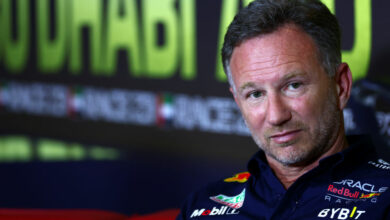George Russell Raises Safety Concerns Over Future Formula 1 Tire Blanket Ban
The Rising Star and GPDA Director Advocates Caution Amidst Sustainability Drive
Formula 1 is no stranger to innovations, but George Russell, the rising star of the racing world, has voiced his concerns about a change that might pose risks to the safety and performance of the sport. Russell, also the director of the Grand Prix Drivers’ Association, recently expressed his reservations about the upcoming tire blanket ban, labeling it as “dangerous.” In addition to his concerns, he suggested that Formula 1 explores alternative sustainable options for tire heating.
The impending tire blanket ban aligns with Formula 1’s commitment to sustainability, as it seeks to reduce its environmental impact. Tire blankets, while essential for performance, have been identified as significant contributors to energy consumption during Grand Prix weekends. These devices are designed to keep the tires at a toasty 70°C for a duration of two hours prior to each racing session. This meticulous temperature maintenance is crucial for ensuring that the tires provide optimal grip when the race begins or when drivers exit the pits.
For the first few laps of a race, maintaining an optimal internal tire temperature is essential. It directly impacts how quickly the tires can generate the necessary heat and traction to deliver top-tier performance on the track. Formula 1’s tire supplier, Pirelli, has been hard at work throughout the season, conducting numerous tests with the goal of creating tires that can rapidly reach their ideal operating temperature without the assistance of tire blankets.
However, despite Pirelli’s efforts and the accumulation of relevant data, the proposal to ban tire blankets faced some resistance from the teams. This debate came to a head during a meeting of the F1 Commission at the Belgian Grand Prix, resulting in a decision to postpone the ban until 2025.
George Russell, known for his exceptional driving skills and insightful perspective, spoke candidly about the potential dangers associated with banning tire blankets. He emphasized that imposing such a change on Formula 1 cars boasting 1000 horsepower and substantial downforce could lead to precarious situations on the track. Russell’s viewpoint underscores the importance of carefully considering the implications of this decision on both driver safety and race performance.
As Formula 1 continues to evolve in pursuit of sustainability and innovation, the tire blanket ban represents a significant shift. While the intention is clear—to reduce energy consumption and minimize the sport’s environmental footprint—George Russell’s concerns remind us that balancing sustainability with safety and performance is a delicate challenge.
In the coming years, Formula 1 will undoubtedly explore alternative methods of tire heating, striving to maintain the thrilling and competitive nature of the sport while minimizing its impact on the planet. As George Russell and other key figures in the racing world weigh in on these changes, the future of Formula 1 promises to be as dynamic as ever.
“A number of drivers feel like it’s a very difficult task for the tyre manufacturers to achieve.
“When you’ve got a 1,000 horsepower car with the downforce we have, to compete with no tyre blankets [it’s] borderline dangerous.
“If we probably put that emphasis on making a more sustainable tyre blanket, we could get a win-win.
“There is a more sustainable tyre blanket out there, I think that’s being developed, and actually the consumption that is used from these tyre blankets is truly not a lot at all.
“So never say never, I’m sure blanket loss is something that we will see maybe in 10 years. But I think we’re a number of years away from it being viable.”

